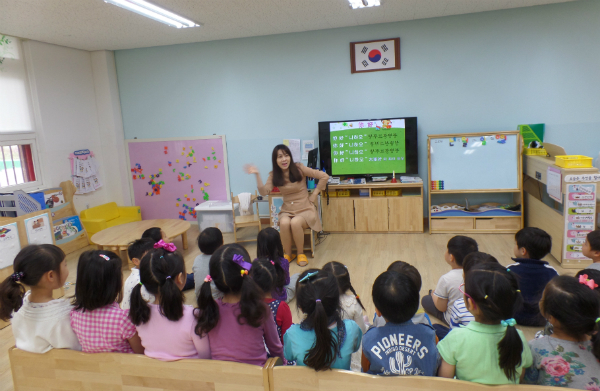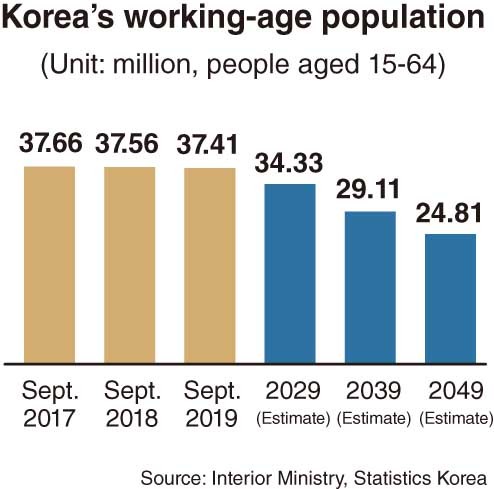[News Focus] Koreans aged 15-64 decrease 370,000 in 3 years
Portion of working-age population falls to 2007 level
By Kim Yon-sePublished : Oct. 30, 2019 - 17:53
SEJONG -- South Korea is projected to see the percentage of the working-age population of the total population fall below the 50 percent mark in 2056, according to Statistics Korea.
Based on monthly statistics, the working-age population in the nation has remained above 70 percent for more a decade.
The working-age population refers to those aged 15 to 64, according to the criteria of the Organization for Economic Cooperation and Development.
According to the Ministry of Interior and Safety, the decline in the number of Koreans aged 15-64 started about three years ago.
Based on monthly statistics, the working-age population in the nation has remained above 70 percent for more a decade.
The working-age population refers to those aged 15 to 64, according to the criteria of the Organization for Economic Cooperation and Development.
According to the Ministry of Interior and Safety, the decline in the number of Koreans aged 15-64 started about three years ago.

The number of Koreans for the large age group peaked at 37.786 million in November 2016. Since then, the figure has continued to drop for 34 consecutive months, despite the nation’s still growing total population.
As of September 2019, the working-age population stood at 37.413 million, fewer by 373,000 from the record high posted 34 months earlier.
In addition, the latest figure marked the lowest in more than six years since it marked 37.412 million in July 2013.
On the basis of proportion, the working-age population peaked at 73.4 percent from October 2011 to January 2012. But the percentage slid by 1.2 percentage points to 72.2 percent in September 2019.
Given that the figure is lower than 72.4 percent recorded in January 2008, when the Interior Ministry began officially compiling data, the current level is estimated to stay at the 2007 level -- that is to say, the lowest point in 12 years.
Data from Statistics Korea forecasts that the proportion of Koreans aged 15-64 will fall below 70 percent in 2024, below 60 percent in 2036 and plunge to 45.4 percent in 2067.
A government official said that “the drop in recent years is critical as Korea’s baby boomer generation, born between 1955 and 1963, still belongs to the working-age population.”
He predicted a steeper decline in the number of Koreans aged 15-64 beginning next year, when those born in 1955 will be classified as seniors, referring to those aged 65 or over.
LG Economic Research Institute estimated that the rapid decline of the working-age population would pull down the nation’s potential growth rate to below 2 percent between 2020 and 2024.
The shrinking workforce was projected to slash gross domestic product growth by 0.4 percentage point between 2020 and 2024, and by 0.5 percentage point between 2025 and 2029.
Currently, Koreans aged 15-64 far surpass those aged 65 or over in proportion, by 72.2 percent to 15.3 percent.

But that percentage gap is estimated to narrow to 65.4 percent vs. 25 percent in 2030; to 56.3 percent vs. 33.9 percent in 2040; and to 51.3 percent vs. 39.8 percent in 2050, Statistics Korea reported.
Further, the working-age population is forecast to be outstripped by the senior population in 2065 (45.9 percent vs. 46.1 percent), which indicates an ultra-aged society, from the current “aged society,” based on the UN definition.
In a similar vein, Korea is projected to see the percentage of those aged up to 14 decline from the current 12.5 percent to 9.8 percent in 2029, 8.9 percent in 2050 and 8 percent in 2060. Ten years ago in September 2009, the youngest generation accounted for 16.7 percent of the total population.
Statistics Korean also expects that Koreans’ average age, which was 42.5 as of September 2019, will reach 54.4 (53.3 for men and 55.5 for women) in 2050.
The average age marked 37.4 (36.3 for men and 38.6 for women) 10 years ago in September 2009.
By Kim Yon-se (kys@heraldcorp.com)







![[Graphic News] More Koreans say they plan long-distance trips this year](http://res.heraldm.com/phpwas/restmb_idxmake.php?idx=644&simg=/content/image/2024/04/17/20240417050828_0.gif&u=)
![[KH Explains] Hyundai's full hybrid edge to pay off amid slow transition to pure EVs](http://res.heraldm.com/phpwas/restmb_idxmake.php?idx=644&simg=/content/image/2024/04/18/20240418050645_0.jpg&u=20240419100350)





![[From the Scene] Monks, Buddhists hail return of remains of Buddhas](http://res.heraldm.com/phpwas/restmb_idxmake.php?idx=652&simg=/content/image/2024/04/19/20240419050617_0.jpg&u=20240419175937)

![[KH Explains] Hyundai's full hybrid edge to pay off amid slow transition to pure EVs](http://res.heraldm.com/phpwas/restmb_idxmake.php?idx=652&simg=/content/image/2024/04/18/20240418050645_0.jpg&u=20240419100350)

![[Today’s K-pop] Illit drops debut single remix](http://res.heraldm.com/phpwas/restmb_idxmake.php?idx=642&simg=/content/image/2024/04/19/20240419050612_0.jpg&u=)